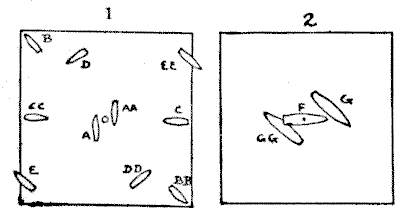
THE CIGAR PUZZLE.—solution
Not a single member of the club mastered this puzzle, and yet I shall show that it is so simple that the merest child can understand its solution—when it is pointed out to him! The large majority of my friends expressed their entire bewilderment. Many considered that "the theoretical result, in any case, is determined by the relationship between the table and the cigars;" others, regarding it as a problem in the theory of Probabilities, arrived at the conclusion that the chances are slightly in favour of the first or second player, as the case may be. One man took a table and a cigar of particular dimensions, divided the table into equal sections, and proceeded to make the two players fill up these sections so that the second player should win. But why should the first player be so accommodating? At any stage he has only to throw down a cigar obliquely across several of these sections entirely to upset Mr. 2's calculations! We have to assume that each player plays the best possible; not that one accommodates the other.
The theories of some other friends would be quite sound if the shape of the cigar were that of a torpedo—perfectly symmetrical and pointed at both ends.
I will show that the first player should infallibly win, if he always plays in the best possible manner. Examine carefully the following diagram, No. 1, and all will be clear.

The first player must place his first cigar on end in the exact centre of the table, as indicated by the little circle. Now, whatever the second player may do throughout, the first player must always repeat it in an exactly diametrically opposite position. Thus, if the second player places a cigar at A, I put one at AA; he places one at B, I put one at BB; he places one at C, I put one at CC; he places one at D, I put one at DD; he places one at E, I put one at EE; and so on until no more cigars can be placed without touching. As the cigars are supposed to be exactly alike in every respect, it is perfectly clear that for every move that the second player may choose to make, it is possible exactly to repeat it on a line drawn through the centre of the table. The second player can always duplicate the first player's move, no matter where he may place a cigar, or whether he places it on end or on its side. As the cigars are all alike in every respect, one will obviously balance over the edge of the table at precisely the same point as another. Of course, as each player is supposed to play in the best possible manner, it becomes a matter of theory. It is no valid objection to say that in actual practice one would not be sufficiently exact to be sure of winning. If as the first player you did not win, it would be in consequence of your not having played the best possible.
The second diagram will serve to show why the first cigar must be placed on end. (And here I will say that the first cigar that I selected from a box I was able so to stand on end, and I am allowed to assume that all the other cigars would do the same.) If the first cigar were placed on its side, as at F, then the second player could place a cigar as at G—as near as possible, but not actually touching F. Now, in this position you cannot repeat his play on the opposite side, because the two ends of the cigar are not alike. It will be seen that GG, when placed on the opposite side in the same relation to the centre, intersects, or lies on top of, F, whereas the cigars are not allowed to touch. You must therefore put the cigar farther away from the centre, which would result in your having insufficient room between the centre and the bottom left-hand corner to repeat everything that the other player would do between G and the top right-hand corner. Therefore the result would not be a certain win for the first player.
click here to go to my blog.
See more interesting puzzles at http://puzzles.50webs.org